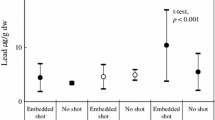Abstract
In a laboratory experiment, conducted over 130 days, three batches of a total of 100 common mussels, Mytilus edulis, were maintained in media containing different lead concentrations. Two vessels served as controls. There was no acute injury to the mussels; but, over an extended period of time, a marked increase in mortality occurred which was related to the lead concentration in the medium. The median lethal time (LT50) was computed to be 218 days for the control, 150 days with 0.5 mg Pb/l in the medium, 129 days with 1 mg/l, and 105 days with 5 mg/l. Quantitative analyses of the soft parts of M. edulis by flameless atomic-absorption-spectrophotometry revealed a distinct accumulation of lead. From a natural lead content of 8.4 μg Pb/g dry weight, the lead concentration increased to 12,840 μg/g at 0.5 mg/l, to 20,770 μg/g at 1 mg/l and to 39,830 μg/g at 5 mg/l. The ratio of the concentration of lead in the soft parts of M. edulis to the concentration in the medium remained in the same order of magnitude both under laboratory conditions using high lead concentrations and under in situ lead levels. Over a period of 130 days, lead uptake expressed as percentage of lead offered was 10.9% at 0.5 mg/l, 9.5% at 1 mg/l, and 3.4% at 5 mg/l, respectively.
Zusammenfassung
-
1.
Je 100 Miesmuscheln Mytilus edulis wurden drei Bleikonzentrationen (0,5; 1; 5 mg Pb/l) ausgesetzt. Die ersten toten Individuen wurden nach 40 Tagen aufgefunden. Bei 130 Tagen Versuchsdauer ergab sich eine deutliche Mortalitätssteigerung gegenüber der Kontrolle mit Erhöhung der Bleikonzentration im Medium. Die LT50 errechnet sich für die Kontrolle mit 218 Tagen, für 0,5 mg Pb/l mit 150 Tagen, für 1 mg/l mit 129 Tagen und für 5 mg/l mit 105 Tagen.
-
2.
Nach 130 Versuchstagen zeigten die Weichkörper starke Bleianreicherung: bei 0,5, 1 bzw. 5 mg Pb/l im Meerwasser stieg die Bleikonzentration auf 12840, 20770 bzw. 39830 μg/g Trockengewicht. Der natürliche Bleigehalt betrug 8,4 μg/g.
-
3.
Der Anreicherungsfaktor für Blei im Muschelweichkörper (Trockengewicht) gegenüber dem Medium liegt mit 8000 bis 40000 in der Natur und im Laborexperiment bei erhöhter Bleikonzentration in derselben Größenordnung. Bis zu 10,9% des im Versuch über 130 Tage angebotenen Bleis wurden von der Muschel aus dem Wasser aufgenommen und im Weichkörper gespeichert. Dieser Prozentsatz sank mit steigendem Bleiangebot.
Similar content being viewed by others
Zitierte Literatur
Abdullah, M. I., L. G. Royle and A. W. Morris: Heavy metal concentration in coastal waters. Nature, Lond. 235, 158–160 (1972).
Brooks, R. R. and M. G. Rumsby: The biogeochemistry of trace elements uptake by some New Zealand bivalves. Limnol. Oceanogr. 10, 521–527 (1965).
Brown, B. and M. Ahsanullah: Effect of heavy metals on mortality and growth. Mar. Pollution Bull. 2, 182–187 (1971).
Gray, J. S. and R. J. Ventilla: Pollution effects on microand meiofauna of sand. Mar. Pollution Bull. 1, 39–43 (1971).
Karbe, L.: Marine Hydroiden als Testorganismen zur Prüfung der Toxizität von Abwasserstoffen. Die Wirkung von Schwermetallen auf Kolonien von Eirene viridula. Mar. Biol. 12, 316–328 (1972).
Preston, A., D. F. Jefferies, J. W. R. Dutton, et al.: British isles coastal waters: The concentrations of selected heavy metals in sea water, suspended matter and biological indicators—a pilot survey. Environ. Pollution 3, 69–82 (1972).
Pringle, B. H., D. E. Hissong, E. L. Katz et al.: Trace metal accumulation by estuarine molluscs. J. sanit. Engng Div. Am. Soc. civ. Engrs 94, 455–475 (1968).
Segar, D. A., J. D. Collins and J. P. Riley: The distribution of major and some minor elements in marine animals. Part II. Molluscs. J. mar. biol. Ass. U.K. 51, 131–136 (1971).
Sprague, J. B.: Measurement of pollutant toxicity to fish. I. Bioassay methods for acute toxicity. Wat. Res. 3, 793–821 (1969).
Tatsumoto, M. T. and C. C. Patterson: The concentration of common lead in seawater. In: Earth science and meteoritics, pp 74–89. Ed. by J. Geiss und E. D. Goldberg. Amsterdam: North Holland Publishing Co. 1963.
Author information
Authors and Affiliations
Additional information
Communicated by O. Kinne, Hamburg
Die vorliegende Arbeit ist Teil einer Dissertation zur Erlangung des Doktorgrades des Fachbereichs Biologie der Universität Hamburg.
Rights and permissions
About this article
Cite this article
Schulz-Baldes, M. Toxizität und anreicherung von blei bei der miesmuschel Mytilus edulis im laborexperiment. Marine Biology 16, 226–229 (1972). https://doi.org/10.1007/BF00346945
Accepted:
Issue Date:
DOI: https://doi.org/10.1007/BF00346945




